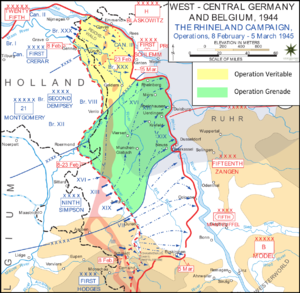| Operation Blockbuster | |||||||
|---|---|---|---|---|---|---|---|
| Part of the Western Allied invasion of Germany in the Western Front of the European theatre of World War II | |||||||
 Operation Blockbuster (yellow) | |||||||
| |||||||
| Belligerents | |||||||
|
|
| ||||||
| Commanders and leaders | |||||||
|
|
| ||||||
Operation Blockbuster was the completion of the larger Operation Veritable by the First Canadian Army, reinforced by the XXX Corps from the British Second Army from late February to early March, 1945. Veritable had been slower and more costly than expected and the Canadian commander, General Harry Crerar, had decided on a fresh start for the operation. Three British and Canadian divisions advanced south-eastwards, capturing unprepared German positions in the Hochwald forested ridge, before advancing on Xanten. They linked up with the Ninth US Army at Berendonk, near Geldern on 3 March.